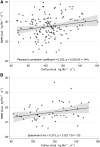Low energy intake plus low energy expenditure (low energy flux), not energy surfeit, predicts future body fat gain
- PMID: 27169833
- PMCID: PMC4880998
- DOI: 10.3945/ajcn.115.127753
Low energy intake plus low energy expenditure (low energy flux), not energy surfeit, predicts future body fat gain
Abstract
Background: There is a paucity of studies that have prospectively tested the energy surfeit theory of obesity with the use of objectively estimated energy intake and energy expenditure in humans. An alternative theory is that homeostatic regulation of body weight is more effective when energy intake and expenditure are both high (high energy flux), implying that low energy flux should predict weight gain.
Objective: We aimed to examine the predictive relations of energy balance and energy flux to future weight gain and tested whether results were replicable in 2 independent samples.
Design: Adolescents (n = 154) and college-aged women (n = 75) underwent 2-wk objective doubly labeled water, resting metabolic rate, and percentage of body fat measures at baseline. Percentage of body fat was measured annually for 3 y of follow-up for the adolescent sample and for 2 y of follow-up for the young adult sample.
Results: Low energy flux, but not energy surfeit, predicted future increases in body fat in both studies. Furthermore, high energy flux appeared to prevent fat gain in part because it was associated with a higher resting metabolic rate.
Conclusion: Counter to the energy surfeit model of obesity, results suggest that increasing energy expenditure may be more effective for reducing body fat than caloric restriction, which is currently the treatment of choice for obesity. This trial was registered at clinicaltrials.gov as NCT02084836.
Keywords: doubly labeled water; energy balance; energy flux; physical activity; weight gain.
© 2016 American Society for Nutrition.
Figures



Comment in
-
Misdefined energy flux and increased fatness.Am J Clin Nutr. 2016 Nov;104(5):1485-1486. doi: 10.3945/ajcn.116.139618. Am J Clin Nutr. 2016. PMID: 27802993 Free PMC article. No abstract available.
-
Reply to DA Schoeller.Am J Clin Nutr. 2016 Nov;104(5):1486-1487. doi: 10.3945/ajcn.116.140731. Am J Clin Nutr. 2016. PMID: 27802994 Free PMC article. No abstract available.
-
Energy balance, energy turnover, and risk of body fat gain.Am J Clin Nutr. 2017 Feb;105(2):540-541. doi: 10.3945/ajcn.116.141887. Am J Clin Nutr. 2017. PMID: 28148505 Free PMC article. No abstract available.
-
Reply to DM Thomas and K Westerterp.Am J Clin Nutr. 2017 Feb;105(2):541. doi: 10.3945/ajcn.116.143651. Am J Clin Nutr. 2017. PMID: 28148506 Free PMC article. No abstract available.
References
-
- World Health Organization. Obesity and overweight [Internet]. Fact Sheet 311. Version current 2016 [cited 2016 Jan 21]. Available from: http://amro.who.int/common/Display.asp?Lang=E&RecID=10203.
-
- Guggenheim EA. Thermodynamics: an advanced treatment for chemists and physicists. 1st ed Amsterdam: North-Holland Publishing Company; 1949.
-
- Forbes GB, Brown MR, Welle SL, Lipinski BA. Deliberate overfeeding in women and men: energy cost and composition of the weight gain. Br J Nutr 1986;56:1–9. - PubMed
-
- Horton TJ, Drougas H, Brachey A, Reed GW, Peters JC, Hill JO. Fat and carbohydrate overfeeding in humans: different effects on energy storage. Am J Clin Nutr 1995;62:19–29. - PubMed
Publication types
MeSH terms
Associated data
LinkOut - more resources
Full Text Sources
Other Literature Sources
Medical

